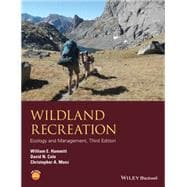THE AUTHORITATIVE GUIDE TO UNDERSTANDING AND MANAGING THE ECOLOGICAL IMPACTS OF RECREATIONAL ACTIVITIES IN WILDLANDS
This third edition provides an updated and thorough examination of the ecological impacts of recreational use on wildlands and the best management practices to employ in places where recreation and preservation of natural conditions are important – and often conflicting – objectives.
Covering the latest research, this edition provides detailed information about the environmental changes that result from recreational use. It describes spatial patterns of impact and trends over time, and then explores the factors that determine the magnitude of impact, including the amount of use, the type and behavior of use, and the environmental durability. Numerous examples, drawn from parks and recreation areas around the world, give readers an insight into why certain areas are more heavily damaged than others, and demonstrate the techniques available to mitigate damage.
The book incorporates both the first-hand experience of the authors and an exhaustive review of the world’s literature on the subject. Boxes provide quick access to important material, and further resources are referenced in an extensive bibliography. Essential reading for all park and protected area management professionals, this book is also a useful textbook for upper division undergraduate and graduate students on recreation ecology and recreation management courses.








